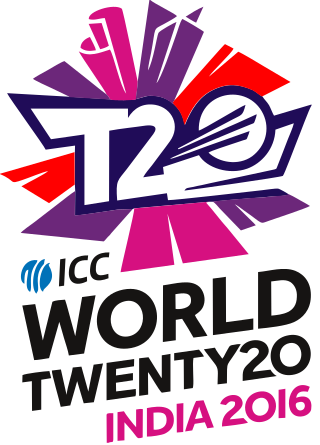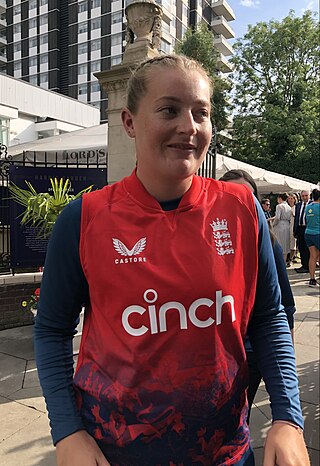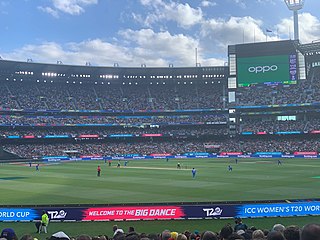
Twenty20 is a shortened format of cricket. At the professional level, it was introduced by the England and Wales Cricket Board (ECB) in 2003 for the inter-county competition. In a Twenty20 game, the two teams have a single innings each, which is restricted to a maximum of twenty overs. Together with first-class and List A cricket, Twenty20 is one of the three forms of cricket recognised by the International Cricket Council (ICC) as being played at the highest level, both internationally and domestically.

Alyssa Jean Healy is an Australian cricketer who plays for and captains the Australian women's national team. She also plays for New South Wales in domestic cricket, as well as the Sydney Sixers in the WBBL and captains the UP Warriorz in Women's Premier League in India. She made her international debut in February 2010.

Anya Shrubsole is an English former cricketer who played as a right-arm medium pace bowler and right-handed lower-order batter. She played for England between 2008 and 2022, and played domestic cricket for Somerset, Berkshire, Western Storm, Southern Vipers, Southern Brave and Perth Scorchers. She made her England debut in 2008, and was Player of the Match in the 2017 Women's Cricket World Cup Final. In 2018, she became the first woman to appear on the cover of Wisden Cricketers' Almanack. In April 2022, Shrubsole announced her retirement from international cricket. In June 2023, she announced her intention to retire from all forms of cricket after the 2023 season of The Hundred.

Shabnim Ismail is a South African former international cricketer who currently playing cricket leagues all over the world. who made her debut for the national women's team in January 2007. A right-arm fast bowler, Ismail is South Africa's all-time leading wicket-taker in both the One Day International and Twenty20 International formats. She has earned a reputation as one of the fastest female bowlers in the world having recorded the fastest ball bowled by a female of 132.1 kilometres per hour (82.1 mph) during the WPL in 2024.She has played in every edition of the ICC Women's World Twenty20 tournament since its inception in 2009. She has featured in ICC World Twenty20 on eight occasions in 2009, 2010, 2012, 2014, 2016, 2018, 2020, 2023.

The 2016 ICC World Twenty20 was the sixth edition of the ICC Men's T20 World Cup, formerly known as the ICC World Twenty20, a Twenty20 International cricket tournament that was held in India from 8 March to 3 April 2016, and was the first edition to be hosted by India.

Megan Louise Schutt is an Australian cricketer who has played for the national team as a fast-medium bowler since 2012. Domestically, she plays for the South Australian Scorpions, for whom she debuted in 2009, and, since 2015, the Adelaide Strikers. She was the first cricketer to take a hat-trick for Australia in a Women's Twenty20 International (WT20I) match.

The 2014 Women's World Twenty20 was the fourth Women's World Twenty20 competition, taking place in Bangladesh from 23 March to 6 April 2014. The tournament was played in the cities of Sylhet and Dhaka – Cox's Bazar was originally intended to also host matches, but the venue was not available due to ongoing development. The tournament featured 10 teams, rather than the eight at previous tournaments, with all matches in the tournament accorded women's Twenty20 International (T20I) status. Bangladesh and Ireland made their first appearances at the event, which was run concurrently with the men's tournament. Australia won the tournament, beating England in the final by six wickets.

Natalie Ruth Sciver-Brunt is an English cricketer who represents England in all formats. She was the first cricketer for England to take a hat-trick in a Women's Twenty20 International match. The "Natmeg" shot is named after Sciver-Brunt, from when she has hit a cricket ball through her legs during a game.

The 2022 ICC Women's Cricket World Cup was the twelfth edition of the Women's Cricket World Cup, which was held in New Zealand in March and April 2022. It was originally scheduled for 6 February to 7 March 2021 but was postponed by one year due to the COVID-19 pandemic. On 15 December 2021, the International Cricket Council (ICC) announced that the tournament would start on 4 March 2022, with the final scheduled for 3 April 2022.

The 2018 Women's World Twenty20 was the sixth edition of the ICC Women's World Twenty20, hosted in the West Indies from 9 to 24 November 2018. It the second World Twenty20 hosted by the West Indies, and the West Indies were the defending champions.

Kimberley Jennifer Garth is an Irish-Australian cricketer who currently plays for Victoria, Melbourne Stars and Australia. An all-rounder, she plays as a right-arm medium bowler and right-handed batter. Between 2010 and 2019, she played international cricket for Ireland, the country of her birth, playing more than 100 matches for the side, before deciding to move to Australia. She made her international debut for Australia in December 2022.

Sophie Ecclestone is an English cricketer who plays for Lancashire, North West Thunder, Manchester Originals, UP Warriorz and England. In December 2018, the International Cricket Council (ICC) named her the Emerging Player of the Year. At the end of the ICC Women's T20 World Cup in March 2020, she became the world's number one bowler in Women's Twenty20 International (WT20I) cricket. In July 2021, Ecclestone was named the ICC Women's Player of the Month for June 2021.

The 2020 Women's T20 World Cup was the seventh Women's T20 World Cup tournament. It was held in Australia between 21 February and 8 March 2020. The final took place at the Melbourne Cricket Ground on International Women's Day. Hosts Australia won the tournament, beating India by 85 runs, to win their fifth title.

The 2023 Women's T20 World Cup was the eighth edition of Women's T20 World Cup tournament. It was held in South Africa between 10 February and 26 February 2023. The final took place at Cape Town. Australia won their sixth and third consecutive title after beating the hosts South Africa in the final by 19 runs.
The 2017 ICC Women's World Cup Final was a women's One Day International cricket match played between England and India to decide the winner of the 2017 Women's World Cup. England won the game by nine runs to secure their fourth World Cup title, with Anya Shrubsole named player of the match. It was one of the closest finals in tournament history, with only the 2000 final being decided by a narrower margin.

The 2020 ICC Women's T20 World Cup Final was a day/night Women's Twenty20 International cricket match played on 8 March 2020 between Australia and India at the Melbourne Cricket Ground in Melbourne. It was the culmination of the 2020 ICC Women's T20 World Cup, the seventh of the tournament history since it started in 2009. Australia won the match by 85 runs, securing their fifth T20 World Cup title. This was the first time that India had reached the final.

















